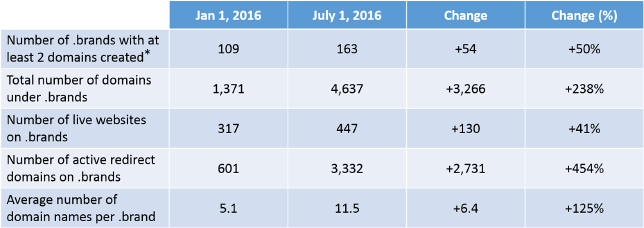


|
||
|
||
Google. BMW. Dell. Canon. Deloitte. Chanel. Microsoft. Audi. Cisco.
Leaders in their industries, household names, game changers in business and technology. And just some of the brands that have launched their .brand TLDs so far in 2016.
As we reach the mid-way point of this year, it provides a fitting checkpoint at which to reflect on the progress we’ve seen over the last six months.
The .brand evolution is not without its challenges, and building mainstream awareness is and will remain a key goal in moving forward. However, Rome wasn’t built in a day—and this blog is about taking a moment to reflect on what has been an incredible start to 2016 for this innovative opportunity and paying respect to the hard work that many .brand owners have done to date in getting these projects off the ground.
In a blog in December last year, I predicted that 2016 was shaping up to be “the year of the .brands”. In the blog, I wrote that “for many brands, progress may be slow, but nothing will be learned by sitting on the sidelines so I expect to see many brands future proofing their businesses and learning via strategic use of their .brand TLDs rather than the wait-and-see approach.”
And from the start of this year, there were only 264 .brand TLDs delegated and within now a few short weeks, we anticipate that this number will reach as many as 400. Pretty amazing progress in such a short window and it doesn’t just stop there.
Consider also that there were 1,371 domains registered in .brands at that time, whereas now we see 4,637 domains currently registered in .brands—an increase of 238% in just 6 months which would certainly been seen as an excellent growth rate if compared to other innovative technologies.
So… how are these domains being used to date? Let’s take a look a bit deeper and analyze them in my ‘Top 5 .brand use categories’ —
* * *
1. Creating the home.brand domain
The .brand movement now has over 31 companies around the world that have created the ‘home.brand’ domain, with the vast majority currently redirecting to their current home page. These includes www.home.microsoft, www.home.cisco and www.home.neustar (shameless plug!), although there are exceptions to the redirect model such as the widely discussed www.home.barclays rebrand.
And whilst many are yet to fully use this in their advertising, the gradual development of ‘home.brand’ as an industry standard and the proof that some of the largest brands in the world have undertaken this approach shows a real understanding of this memorable long term option for customers to find the organization’s home page.
2. Redirections to deep content
Another fantastic use of .brands we’ve seen during the first half of this year is the concept of helping customers to navigate efficiently to deeper existing content—in one simple and intuitive domain name.
What do www.surface.microsoft and www.security.cisco have in common? They take you exactly where you’d expect and directly to the information you’re trying to find—effectively what marketers have been trying to do in advertising for years, right?
3. Specific microsites
This approach of launching a new property outside the legacy domain or existing website is different in its strategic intent, yet is still remarkably powerful. Take a look at the seriously impressive www.next100.bmw site to see how BMW is leveraging its .brand to launch new concepts that tie directly into the organization’s identity and strategic vision.
4. Brand/social alignment
We all know the power of social media and almost every large corporate has its own Facebook and Twitter page. Audi’s ability to link its brand with its social content at www.twitter.audi and www.facebook.audi is a wonderful move and creates memorable access for their customers seeking to find this content directly and with ease.
5. Full transitions
Ok, so we can all pretty much agree that this takes a bold move and complete senior executive support. However, as I mentioned in my blog a few months ago, the commitment from organizations like Canon to change their global home page to the .canon extension is absolutely incredible.
Even better, type in www.canon.com and watch how it seamlessly (and politely in true Japanese style) redirects to the new www.global.canon domain and even includes some illustration on the page as to what’s happened. Brilliant!
* * *
Finally, let’s take a look at a scorecard for .brand usage over the last 6 months to see where these changes have been occurring in the global environment.

* nic.brand is a mandatory domain so can be misleading, hence using two domains as the benchmark.
It’s important to remember that the numbers are only part of the story. The sheer size and market prominence of the brands that have launched is significant in itself, and the influence these organizations have as businesses and as innovative marketers cannot be understated. Involvement in the .brand space by the likes of Deloitte, Hitachi and Sky amongst the others previously mentioned here speak volumes to .brands’ ability to create new platforms for innovative marketing.
As each new organization joins this elite group with its .brand TLD, the apprehension towards being ‘the first to go’ becomes less apparent and the ability for others to follow the path created by the pioneers becomes increasingly clear.
The first six months of 2016 have indeed been a time of exciting launches, diverse strategies and increasing growth in .brands, but in a space of such endless potential for innovation I have no doubt there is plenty more to come as the year continues.
This is just the start of this digital branding evolution—and my Neustar colleagues and I are most certainly honored to play our part in it.
Sponsored byIPv4.Global

Sponsored byCSC

Sponsored byDNIB.com

Sponsored byRadix

Sponsored byWhoisXML API

Sponsored byVerisign

Sponsored byVerisign

In French, we don’t say “home” but “maison”.
:-)